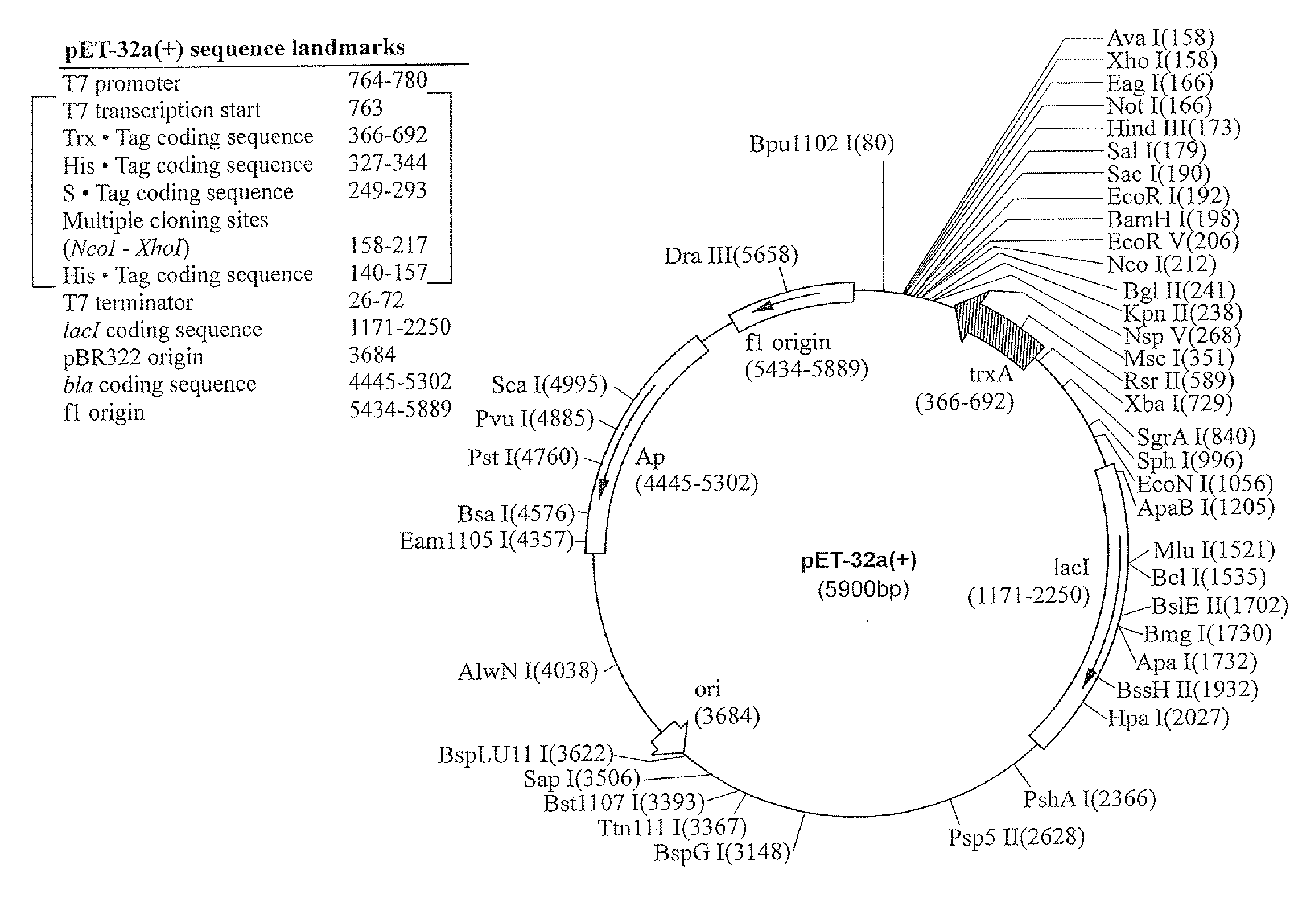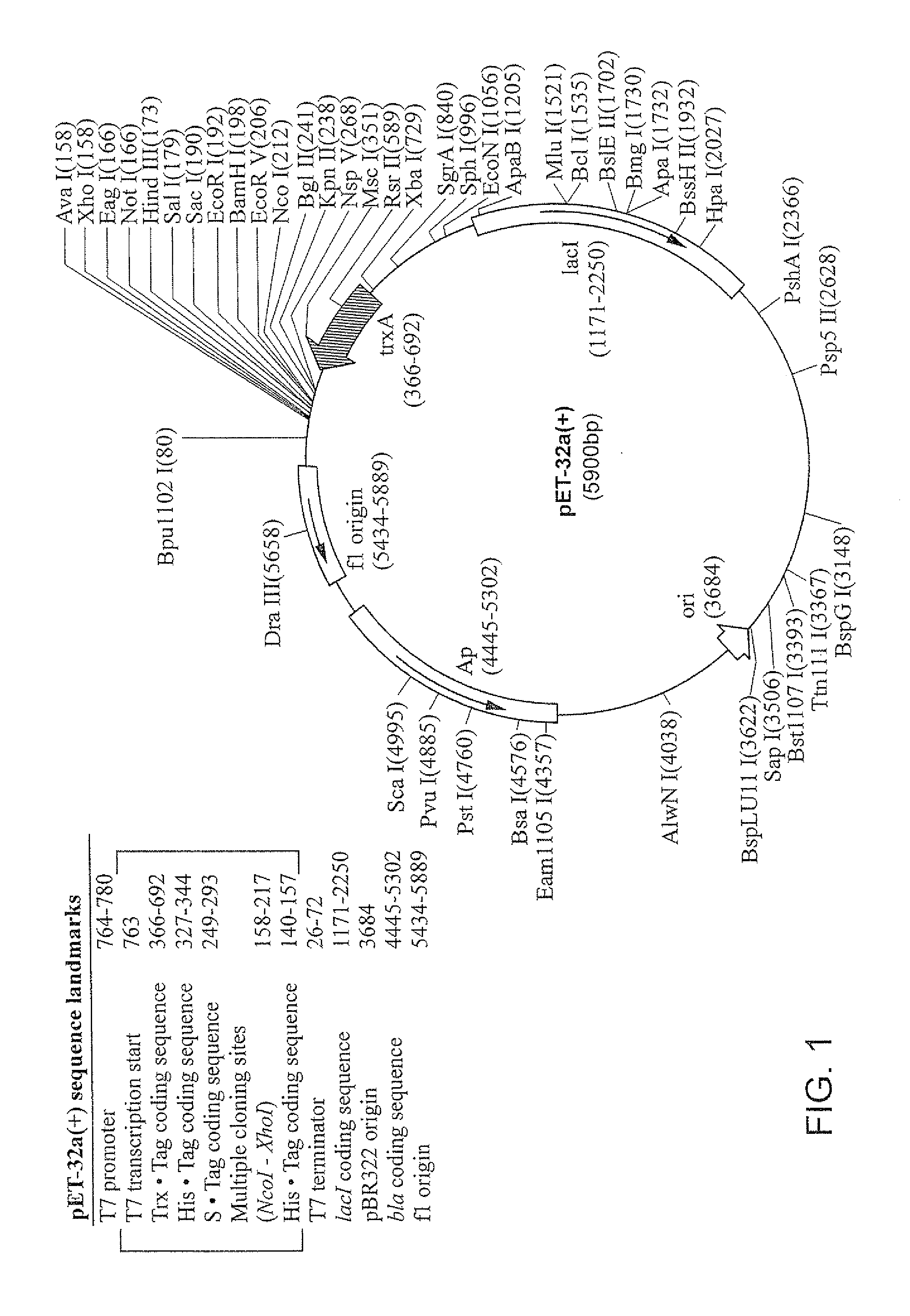HPV antigens, vaccine compositions, and related methods
a technology of hpv and composition, applied in the field of hpv antigens and vaccine compositions, can solve the problems of limited treatment of cervical dysplasia, associated morbidity and expense, and normal-appearing hpv-infected tissue untreated,
- Summary
- Abstract
- Description
- Claims
- Application Information
AI Technical Summary
Benefits of technology
Problems solved by technology
Method used
Image
Examples
example 1
Generation of Vaccine Candidate Constructs
[0160]Generation of Antigen Sequences from Human Papilloma Virus
[0161]Because of safety concerns, the HPV16 E7 oncogene (KO2718, Seedorf et al., 1985, Virology, 145:181) already cloned into pQE30 (pQE30-E7) between BamHI / PstI restriction sites, was mutated using the Quikchange Site-Directed Mutagenesis Kit (Stratagene) to generate the plasmid pQE30-E7GGG. Three point mutations were introduced into the pRB-binding site of the E7 gene as indicated by the bolded oligonucleotides of the forward and backward “fast polynucleotide liquid chromatography”-purified primers designed to introduce the mutations, respectively:
[0162]The introduced mutations, resulted in the substitution of three amino acids in the E7 protein sequence: D21G (Asp21>Gly), C24G (Cys24>Gly), E26G (Glu26>Gly) abolishing the E7 protein transformation potential. The authenticity of the resultant gene, denoted E7GGG, was confirmed by sequencing
HPV16 E7 (KO2718, Seedorf et al., supr...
example 2
Generation of Vaccine Candidate Antigen Vectors
[0166]Target antigen constructs LicKM-E7 or LicKM-E7GGG were individually subcloned into the chosen viral vector (pB1-D4). pB1-D4 is a pBI121-derived binary vector in which the reporter gene coding for the E. coli β-D-glucuronidase (GUS) has been replaced by a “polylinker” where, between the XbaI and SacI sites, a TMV-derived vector has been cloned (FIG. 3). pBI-D4 is a TMV-based construct in which a foreign gene to be expressed (e.g., target antigen (e.g., LicKM-E7, LicKM-E7GG) replaces the coat protein (CP) gene of TMV. The virus retains the TMV 126 / 183 kDa gene, the movement protein (MP) gene, and the CP subgenomic mRNA promoter (sgp), which extends into the CP open reading frame (ORF). The start codon for CP has been mutated. The virus lacks CP and therefore cannot move throughout the host plant via phloem. However, cell-to-cell movement of viral infection remains functional, and the virus can move slowly to the upper leaves in this...
example 3
Generation of Plants and Antigen Production
Agrobacterium Infiltration of Plants
[0167]Agrobacterium-mediated transient expression system achieved by Agrobacterium infiltration can be utilized (Turpen et al., 1993, J. Virol. Methods, 42:227). Healthy leaves of N. benthamiana were infiltrated with A. rhizogenes containing viral vectors engineered to express LicKM-E7 or LicKM-E7GGG.
[0168]The A. rhizogenes strain A4 (ATCC 43057) or A. tumefaciens (GV3103) was transformed with the constructs pB1-D4-PRACS-LicKM-E7-KDEL, pB1-D4-PRACS-LicKM-E7VAC, pB1-D4-PRACS-LicKM-E7GGG-KDEL and pB1-D4-PRACS-LicKM-E7GGG-VAC. Agrobacterium cultures were grown and induced as described (Kapila et al., 1997, Plant Sci., 122:101). A 2 ml starter-culture (picked from a fresh colony) was grown overnight in YEB (5 g / l beef extract, 1 g / l yeast extract, 5 g / l peptone, 5 g / l sucrose, 2 mM MgSO4) with 25 μg / ml kanamycin at 28° C. The starter culture was diluted 1:500 into 500 ml of YEB with 25 μg / ml kanamycin, 10 mM ...
PUM
| Property | Measurement | Unit |
|---|---|---|
| temperature | aaaaa | aaaaa |
| time | aaaaa | aaaaa |
| time | aaaaa | aaaaa |
Abstract
Description
Claims
Application Information
 Login to View More
Login to View More - R&D
- Intellectual Property
- Life Sciences
- Materials
- Tech Scout
- Unparalleled Data Quality
- Higher Quality Content
- 60% Fewer Hallucinations
Browse by: Latest US Patents, China's latest patents, Technical Efficacy Thesaurus, Application Domain, Technology Topic, Popular Technical Reports.
© 2025 PatSnap. All rights reserved.Legal|Privacy policy|Modern Slavery Act Transparency Statement|Sitemap|About US| Contact US: help@patsnap.com



